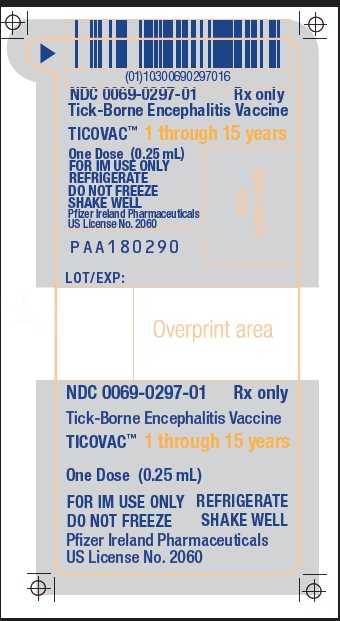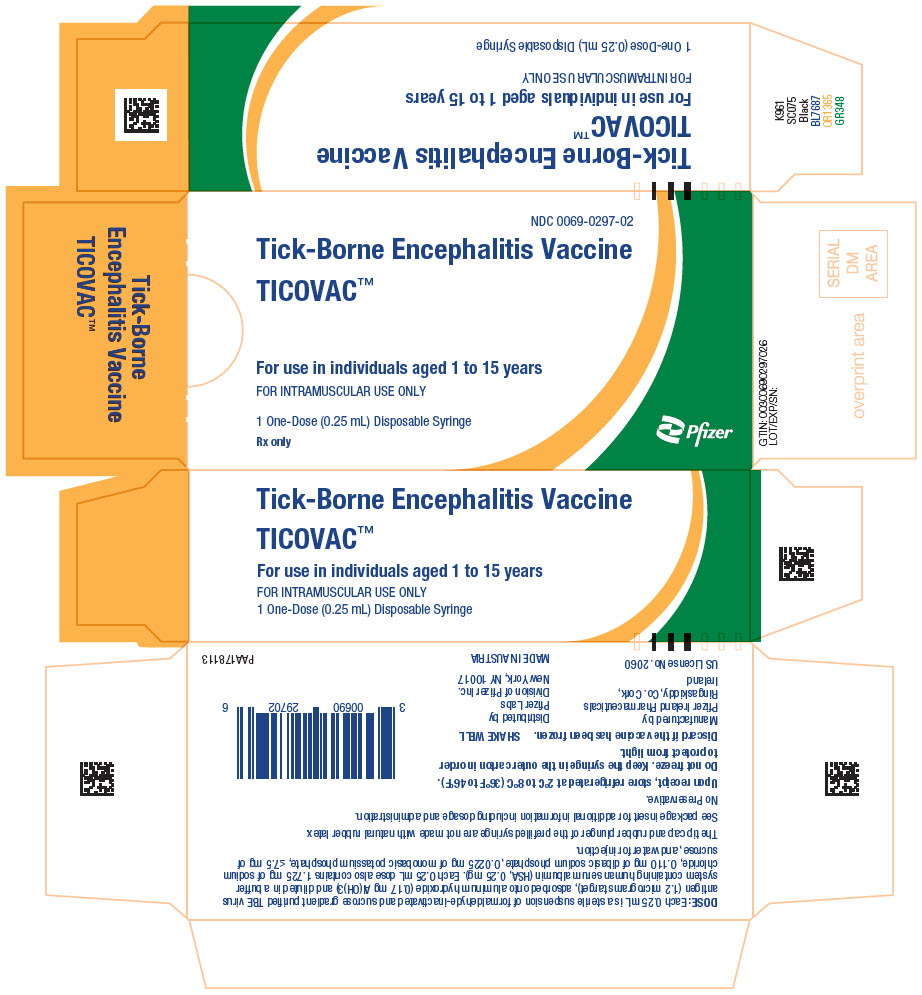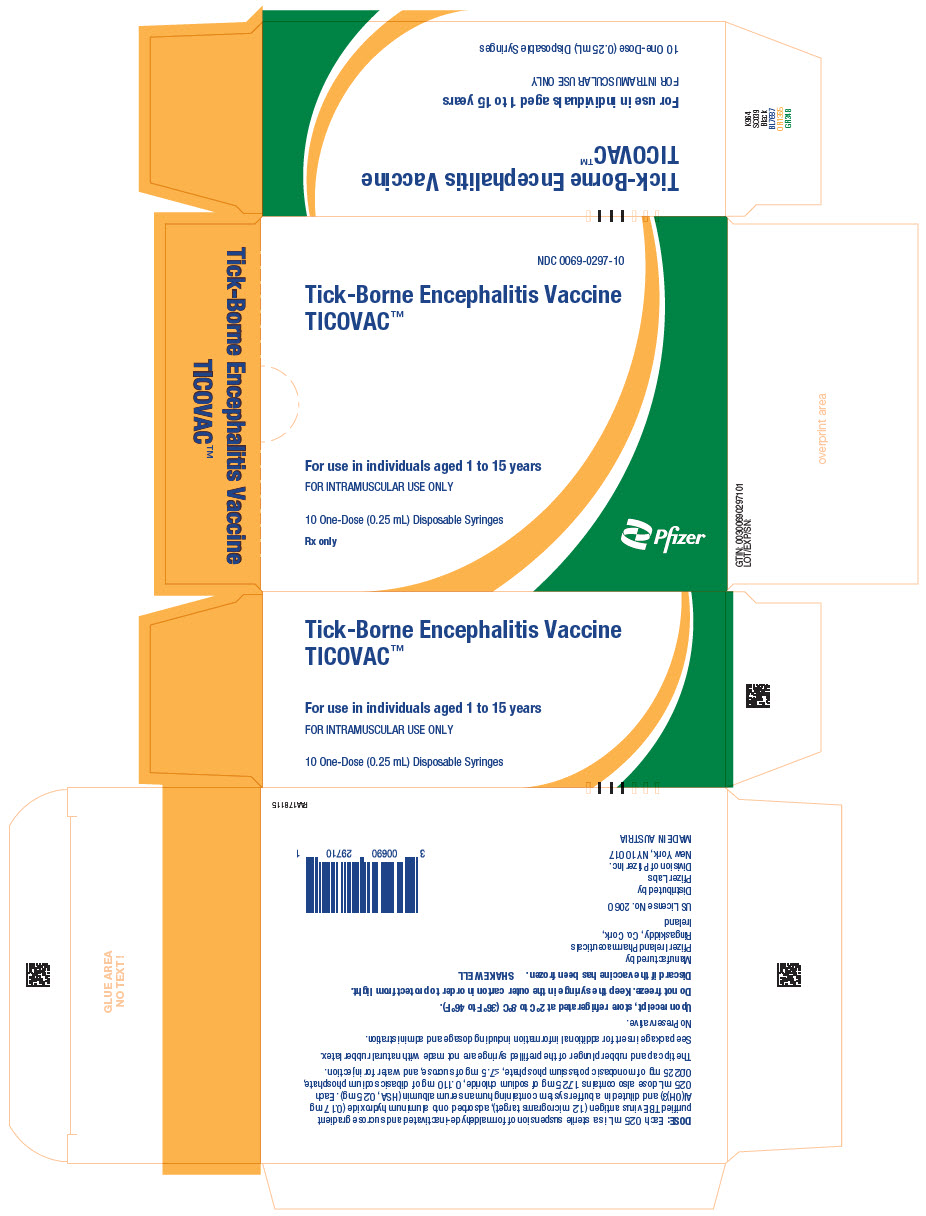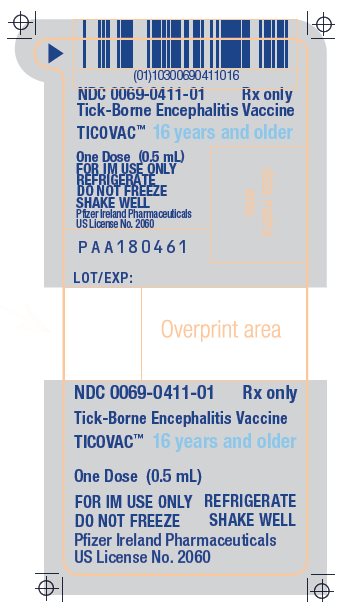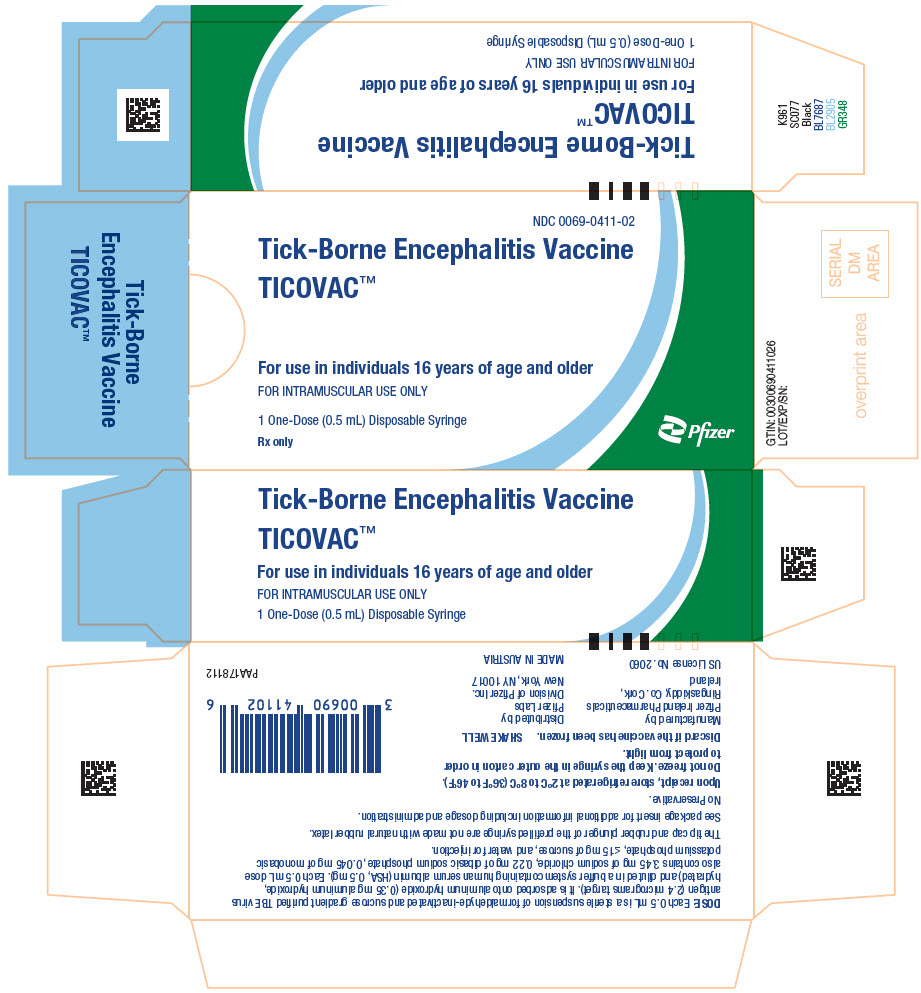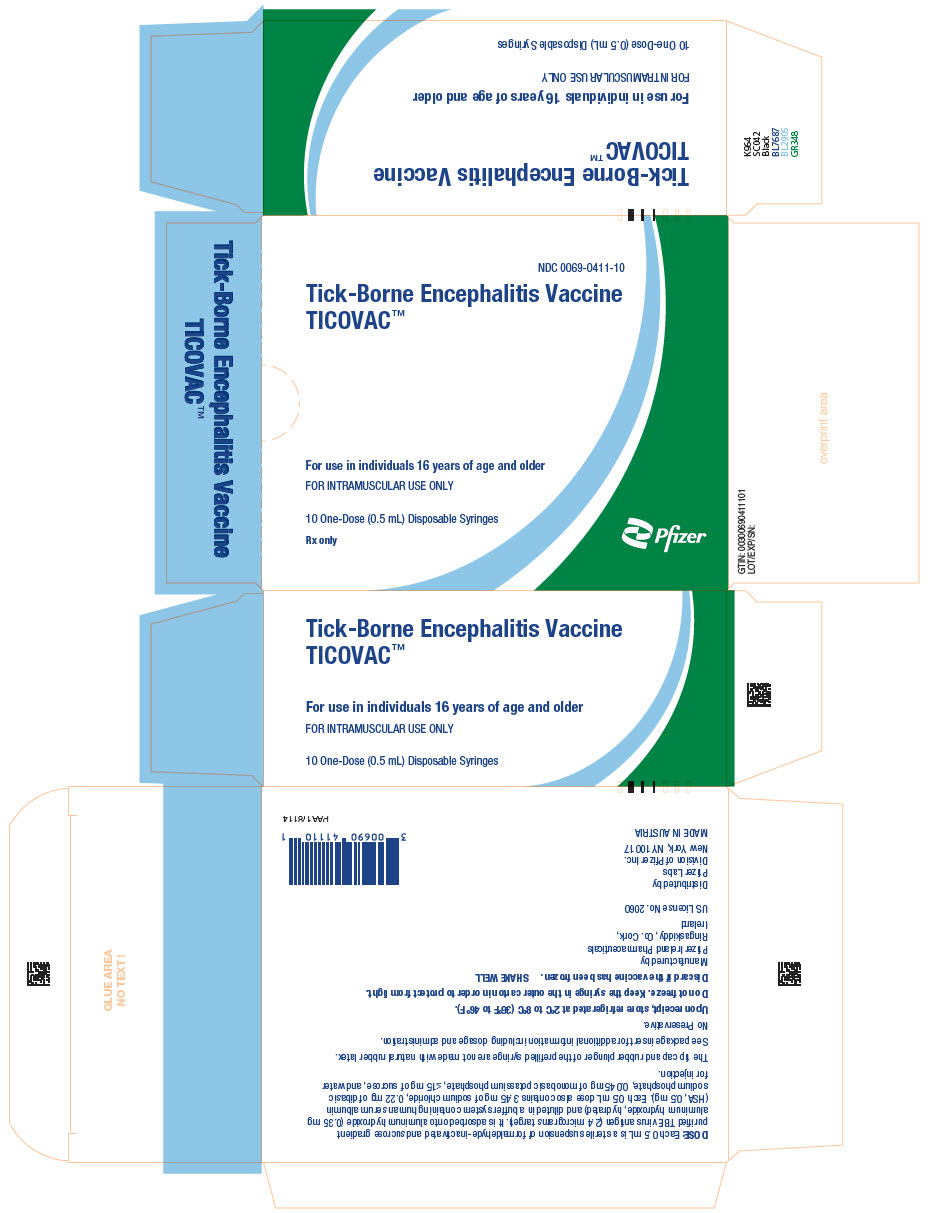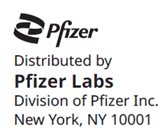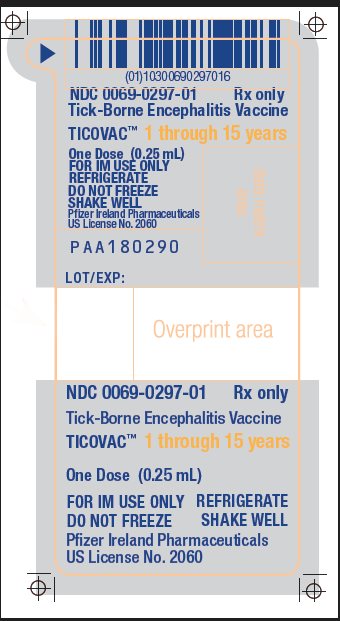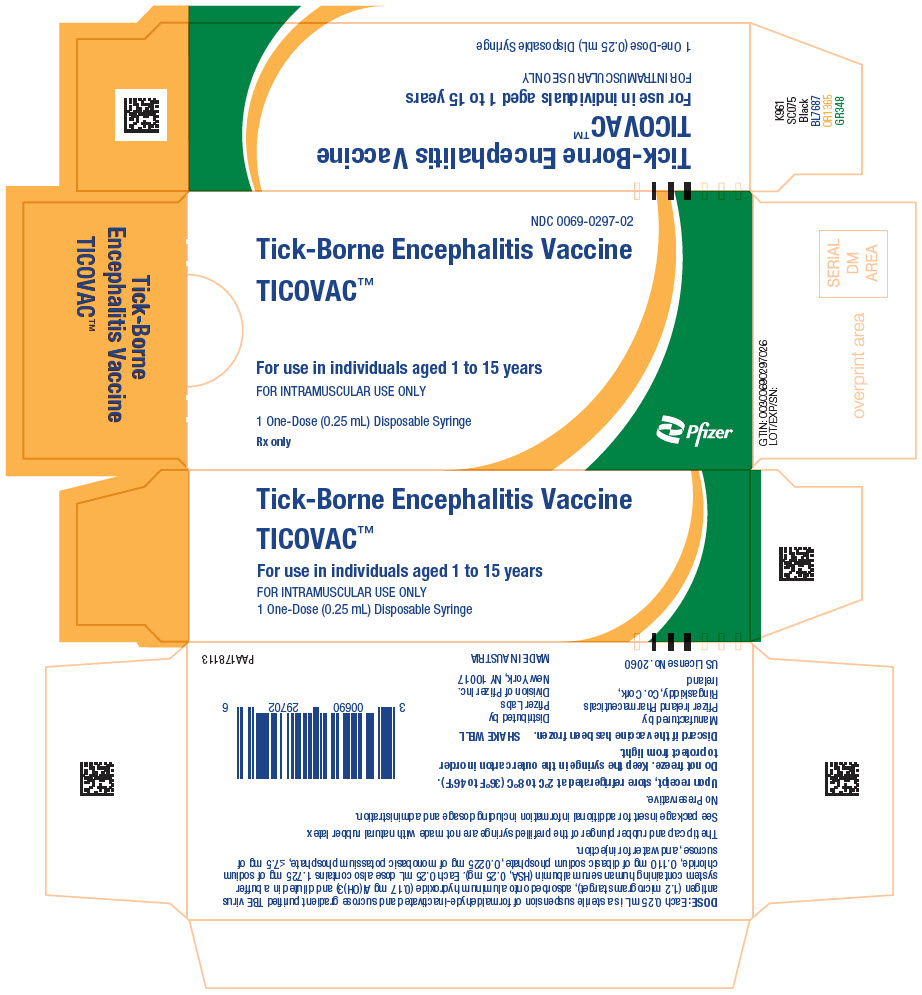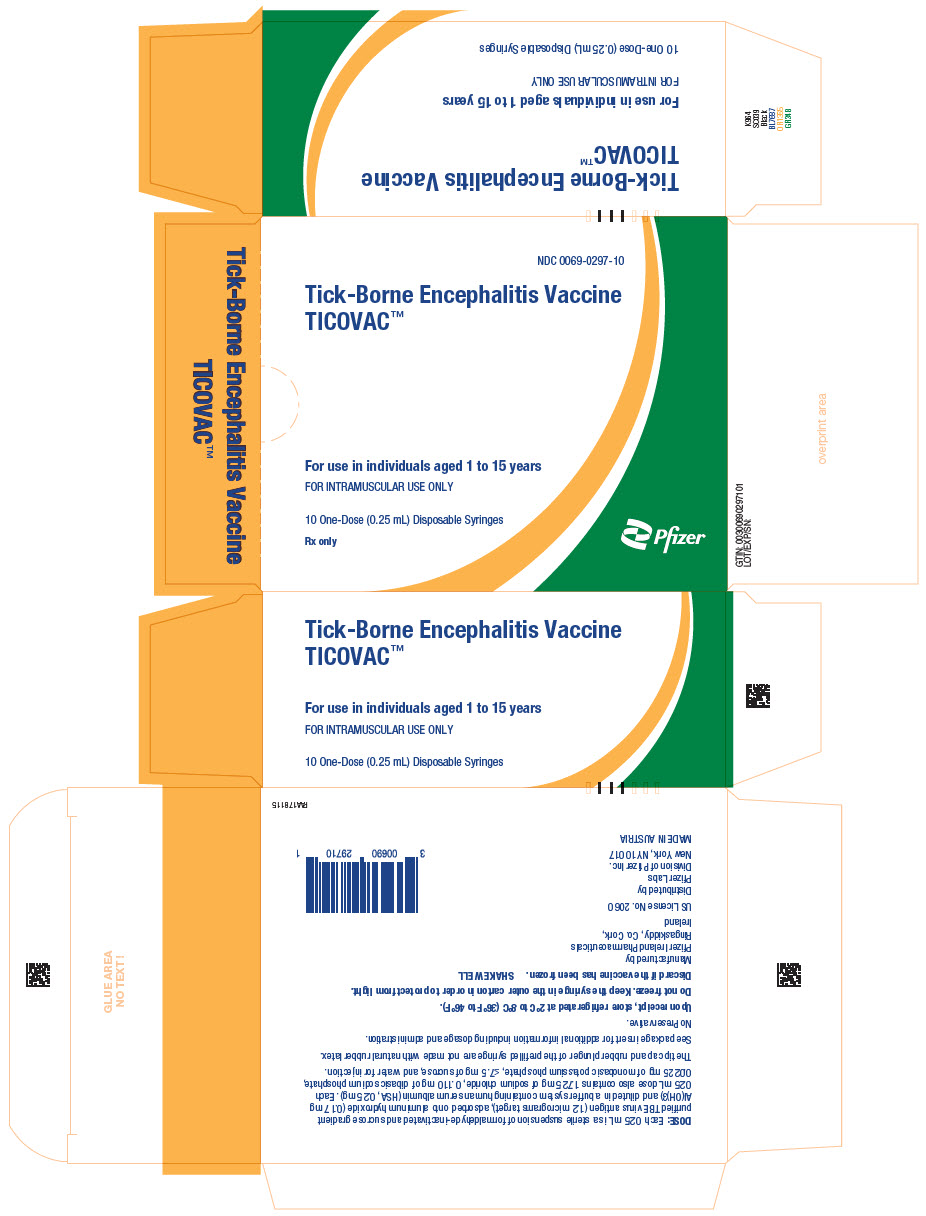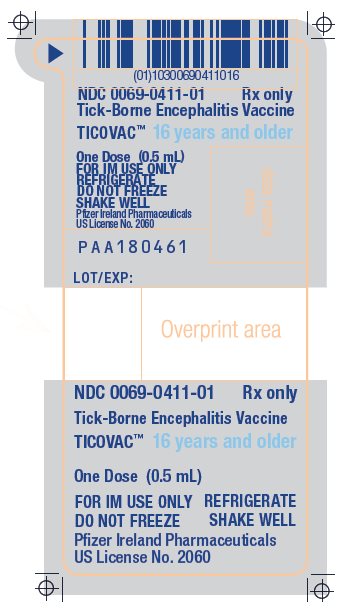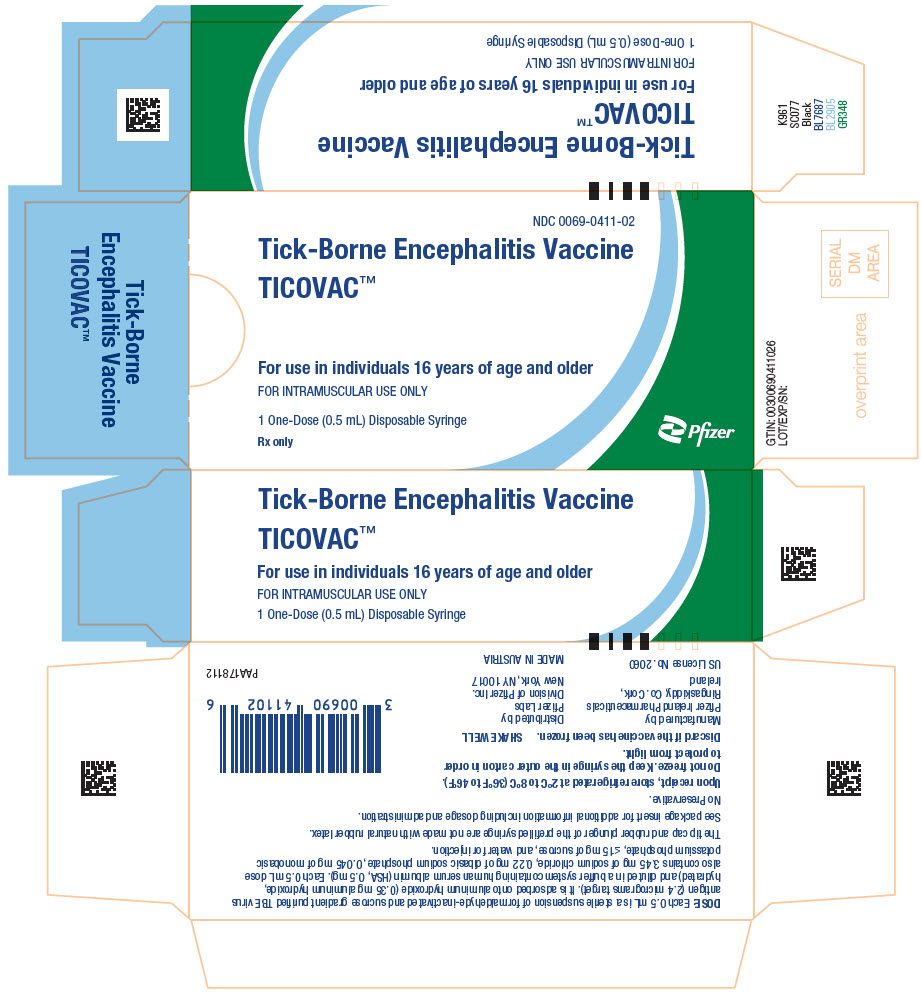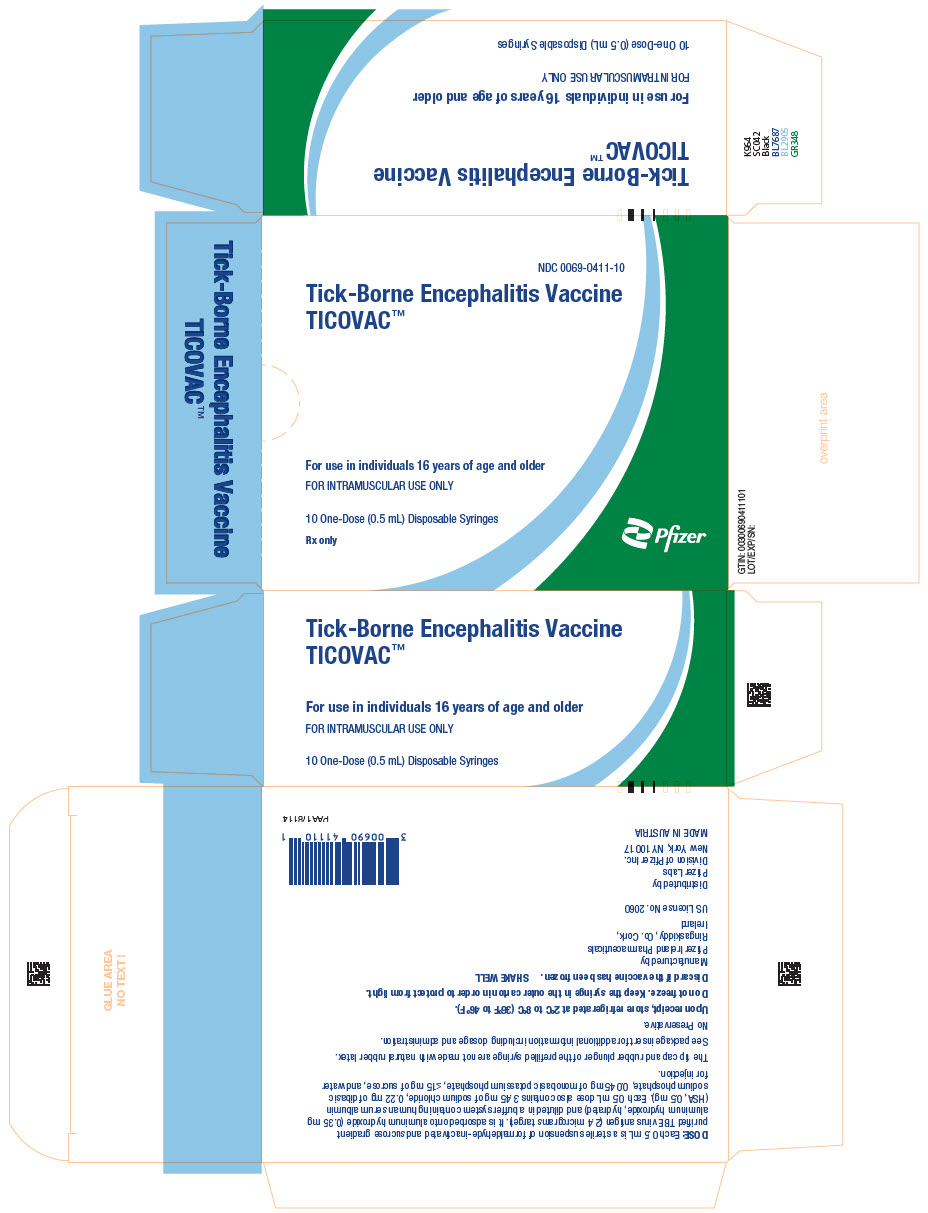Label: TICOVAC- tick-borne encephalitis vaccine injection
-
NDC Code(s):
0069-0297-01,
0069-0297-02,
0069-0297-10,
0069-0411-01, view more0069-0411-02, 0069-0411-10
- Packager: Pfizer Laboratories Div Pfizer Inc
- Category: VACCINE LABEL
- DEA Schedule: None
- Marketing Status: Biologic Licensing Application
Drug Label Information
Updated July 24, 2023
If you are a consumer or patient please visit this version.
- Download DRUG LABEL INFO: PDF XML
- Official Label (Printer Friendly)
-
HIGHLIGHTS OF PRESCRIBING INFORMATION
These highlights do not include all the information needed to use TICOVAC safely and effectively. See full prescribing information for TICOVAC.
TICOVAC (Tick-Borne Encephalitis Vaccine), Suspension for intramuscular injection
Initial U.S. Approval: 2021INDICATIONS AND USAGE
TICOVAC is a vaccine indicated for active immunization to prevent tick-borne encephalitis (TBE). TICOVAC is approved for use in individuals 1 year of age and older. (1)
DOSAGE AND ADMINISTRATION
For intramuscular use only.
- •
- 1 through 15 years of age: each dose 0.25 mL
- •
- 16 years of age and older: each dose 0.5 mL
Primary Vaccination: Three doses (2.1)
Primary Vaccination Schedule 1 through 15 years of age
16 years of age and older
First dose
Day 0
Day 0
Second dose
1 to 3 months after the first vaccination
14 days to 3 months after the first vaccination
Third dose
5 to 12 months after the second vaccination
5 to 12 months after the second vaccination
A booster dose (fourth dose) may be given at least 3 years after completion of the primary immunization series if ongoing exposure or re-exposure to tick-borne encephalitis virus (TBEV) is expected.
DOSAGE FORMS AND STRENGTHS
Suspension for injection supplied as a 0.25 mL or 0.5 mL single-dose in pre-filled syringes. (3)
CONTRAINDICATIONS
- •
- Severe allergic reaction (e.g. anaphylaxis) to any component of TICOVAC. (4)
ADVERSE REACTIONS
The most common adverse reactions are as follows:
- •
- 1 through 15 years of age: Local tenderness (18.1%), local pain (11.2%), headache (11.1%), fever (9.6%), and restlessness (9.1%). (6.1)
- •
- 16 through 65 years of age: Local tenderness (29.9%), local pain (13.2%), fatigue (6.6%), headache (6.3%), and muscle pain (5.1%). (6.1)
To report SUSPECTED ADVERSE REACTIONS, contact Pfizer Inc. at 1-800-438-1985 or VAERS at 1-800-822-7967 or https://vaers.hhs.gov.
See 17 for PATIENT COUNSELING INFORMATION.
Revised: 7/2023
-
Table of Contents
FULL PRESCRIBING INFORMATION: CONTENTS*
1 INDICATIONS AND USAGE
2 DOSAGE AND ADMINISTRATION
2.1 Dosage and Vaccination Schedule
2.2 Administration
3 DOSAGE FORMS AND STRENGTHS
4 CONTRAINDICATIONS
5 WARNINGS AND PRECAUTIONS
5.1 Management of Acute Allergic Reactions
5.2 Altered Immunocompetence
5.3 Human Albumin
5.4 Limitation of Vaccine Effectiveness
6 ADVERSE REACTIONS
6.1 Clinical Trials Experience
6.2 Postmarketing Experience
8 USE IN SPECIFIC POPULATIONS
8.1 Pregnancy
8.2 Lactation
8.4 Pediatric Use
8.5 Geriatric Use
11 DESCRIPTION
12 CLINICAL PHARMACOLOGY
12.1 Mechanism of Action
13 NONCLINICAL TOXICOLOGY
13.1 Carcinogenesis, Mutagenesis, Impairment of Fertility
14 CLINICAL STUDIES
14.1 Immunogenicity
14.2 Field Vaccine Effectiveness
15 REFERENCES
16 HOW SUPPLIED/STORAGE AND HANDLING
16.1 How Supplied
16.2 Storage and Handling
17 PATIENT COUNSELING INFORMATION
- *
- Sections or subsections omitted from the full prescribing information are not listed.
- 1 INDICATIONS AND USAGE
-
2 DOSAGE AND ADMINISTRATION
For intramuscular use only.
2.1 Dosage and Vaccination Schedule
- •
- 1 through 15 years of age: each dose 0.25 mL
- •
- 16 years of age and older: each dose 0.5 mL
Primary Vaccination: Three doses
Table 1: Primary Vaccination Schedule - TICOVAC 1 through 15 years of age 16 years of age and older First dose
Day 0
Day 0
Second dose
1 to 3 months after the first vaccination
14 days to 3 months after the first vaccination
Third dose
5 to 12 months after the second vaccination
5 to 12 months after the second vaccination
Complete the primary immunization series at least 1 week prior to potential exposure to TBEV (tick-borne encephalitis virus) [see Clinical Studies (14.1)].
A booster dose (fourth dose) may be given at least 3 years after completion of the primary immunization series if ongoing exposure or re-exposure to TBEV is expected.
2.2 Administration
Bring the vaccine to room temperature before administration. Shake well prior to administration to thoroughly mix the vaccine suspension. After shaking, the vaccine should be a homogenous off-white, opalescent suspension. Parenteral drug products should be inspected visually for particulate matter and discoloration prior to administration, whenever solution and container permit. Do not administer if particulate matter or discoloration remains after shaking. Administer vaccine by intramuscular injection.
- 3 DOSAGE FORMS AND STRENGTHS
- 4 CONTRAINDICATIONS
-
5 WARNINGS AND PRECAUTIONS
5.1 Management of Acute Allergic Reactions
Appropriate medical treatment and supervision must be available to manage possible anaphylactic reactions following administration of TICOVAC.
5.2 Altered Immunocompetence
Some individuals with altered immunocompetence may have reduced immune responses to TICOVAC.
5.3 Human Albumin
TICOVAC contains albumin, a derivative of human blood. Based on effective donor screening and product manufacturing processes, it carries an extremely remote risk for transmission of viral diseases and variant Creutzfeldt-Jakob disease (vCJD). There is a theoretical risk for transmission of Creutzfeldt-Jakob disease (CJD), but if that risk actually exists, the risk of transmission would also be considered extremely remote. No cases of transmission of viral diseases, CJD or vCJD have ever been identified for licensed albumin or albumin contained in other licensed products.
-
6 ADVERSE REACTIONS
In clinical studies, the most common adverse reactions in subjects 1 through 15 years of age who received TICOVAC were local tenderness (18.1%), local pain (11.2%), headache (11.1%), fever (9.6%), and restlessness (9.1%).
The most common adverse reactions in subjects 16 through 65 years of age who received TICOVAC were local tenderness (29.9%), local pain (13.2%), fatigue (6.6%), headache (6.3%), and muscle pain (5.1%).
6.1 Clinical Trials Experience
Because clinical trials are conducted under widely varying conditions, adverse reaction rates observed in the clinical trials of a vaccine cannot be directly compared to rates in the clinical trials of another vaccine and may not reflect the rates observed in practice.
Among a total of 10 clinical trials, 3240 healthy children 1 through 15 years of age received at least one dose of TICOVAC. A total of 4427 healthy adults 16 years of age and older received at least one dose of TICOVAC in 10 clinical trials.
Study 209 was a multicenter, open-label study to investigate the safety of TICOVAC in 2,417 healthy children 1 through 15 years of age who received three vaccinations (Day 0, 1 and 6 months after the first vaccination). The incidence rates for local and systemic solicited adverse reactions within 4 days after each dose are presented in Table 2.
Table 2: Incidence Rates of Solicited Local and Systemic Adverse Reactions Within 4 Days After Each Dose of TICOVAC, Children 1 through 15 Years of Age (Study 209) Percentage (%) of Subjects Age Group* Adverse Reaction Dose 1
N=2417Dose 2
N=2410Dose 3
N=2390Abbreviation: N=total number of subjects who received TICOVAC at each dose for each age group. Clinical trial identifier: NCT 00161863. - *
- Some symptoms were solicited using different terms in younger and older children, to be age appropriate.
Local Reaction
1–15 Years
Tenderness
18.1
12.9
13.3
Local pain
11.2
7.9
9.7
Erythema
3.0
1.5
2.8
Induration
2.2
1.3
2.1
Swelling
1.9
1.1
2.5
Itching
<0.1
<0.1
0
Ecchymosis
0
0
<0.1
Hematoma
<0.1
0
0
Systemic Reaction
1–15 Years
Fever
9.6
2.3
2.4
Headache
11.1
3.9
3.4
Muscle pain
3.6
2.0
1.8
Loss of appetite
3.1
1.5
1.2
Nausea
3.3
1.0
0.8
Changes in sleeping behavior
2.8
1.0
0.8
Vomiting
1.7
0.7
0.3
Joint pain
1.2
0.6
0.5
Swelling of the axillary /inguinal lymph nodes
0.2
0.3
0.2
N=584
N=581
N=576
1–5 Years
Restlessness
9.1
3.6
3.5
N=1833
N=1829
N=1814
6–15 Years
Fatigue
6.3
2.4
2.5
Malaise
4.8
1.6
1.8
Incidence rates of fever reported within 4 days after each dose of TICOVAC, by age group, in Study 209 are presented in Table 3.
Table 3: Fever Rates Within 4 Days After Each Dose of TICOVAC by Age Group (Study 209) Dose
Age GroupPercentage (%) of Subjects 38.0–38.4°C
(100.4–101.1°F)38.5–38.9°C
(101.2–102.0°F)39.0–40.0°C
(102.1–104°F)>40°C
(>104°F)Abbreviation: N=total number of subjects who received TICOVAC at each dose for each age group. Clinical trial identifier: NCT 00161863. Dose 1
1–2 Years of Age (N=186)
23.7
5.9
5.9
0
3–6 Years of Age (N=563)
4.6
5.0
3.0
0
7–15 Years of Age (N=1668)
3.4
2.0
0.3
0
Total (N=2417)
5.2
3.0
1.4
0
Dose 2
1–2 Years of Age (N=185)
9.2
2.2
0.5
0.5
3–6 Years of Age (N=561)
1.2
0.4
0.5
0
7–15 Years of Age (N=1664)
0.8
0.4
<0.1
0
Total (N=2410)
1.6
0.5
0.2
<0.1
Dose 3
1–2 Years of Age (N=184)
7.1
3.8
1.6
0
3–6 Years of Age (N=557)
1.4
0.4
0.7
0.2
7–15 Years of Age (N=1649)
0.6
0.3
0.2
0
Total (N=2390)
1.3
0.6
0.5
<0.1
The following additional adverse reactions to the vaccine have been reported in <1% of subjects 1 through 15 years of age who received TICOVAC in clinical trials (N=3240): vertigo, dizziness, sensory abnormalities, abdominal pain, diarrhea, dyspepsia, injection site pruritus, and urticaria.
Study 208 was a randomized, comparative, single-blind study that assessed the safety of TICOVAC. Healthy subjects 16 through <65 years of age (N=3966) were randomized 3:1 to receive two vaccinations with either TICOVAC or a non-US licensed TBE vaccine comparator administered 21 to 35 days apart. Study 213 was an open-label follow-up study to Study 208; all subjects who had received two vaccinations in Study 208 (regardless of which vaccine they had received) were eligible and received a third vaccination with TICOVAC 6 months after the first vaccination in Study 208 (N=3705).
Incidence rates of solicited local and systemic adverse reactions reported in Study 208 (Doses 1 and 2) and Study 213 (Dose 3) are presented in Table 4.
Table 4: Incidence Rates of Specifically Solicited Local and Systemic Adverse Reactions Within 4 Days After Each Dose of TICOVAC, Subjects 16 through <65 Years of Age (Study 208/213) Percentage (%) of Subjects Adverse Reaction Dose 1
N=2977*Dose 2
N=2950†Dose 3‡
N=2790‡Clinical trial identifiers: NCT00161824 and NCT00161876. Local Reaction
Tenderness
29.9
27.4
25.7
Local pain
13.2
13.5
12.0
Erythema
3.6
2.3
3.4
Induration
2.0
1.5
2.6
Swelling
1.6
1.4
2.0
Hematoma
<0.1
<0.1
0.1
Ecchymosis
<0.1
0
<0.1
Systemic Reaction
Fever
0.8
0.5
0.5
Fatigue
6.6
4.1
5.3
Headache
6.3
4.4
4.9
Muscle pain
5.1
3.7
3.8
Malaise
4.9
3.3
3.7
Joint pain
1.4
1.1
1.4
Nausea
2.1
0.9
1.0
Swelling of the lymph nodes
0.6
0.3
0.7
Vomiting
0.2
0.1
<0.1
The following additional adverse reactions have been reported in <1% of subjects 16 through <65 years of age who received TICOVAC in clinical trials (N=4427): hypersensitivity, somnolence, vertigo, diarrhea, abdominal pain, injection site pruritus, and injection site warmth.
Subjects who were seropositive either by ELISA or NT 1 month after the third dose in Studies 209 and 208/213, were invited to participate in follow-up Studies 700401 and 223 (studies assessing antibody persistence and response to a booster dose at 3 years), respectively. A total of 156 subjects received a fourth dose of TICOVAC (0.25 mL), and 240 subjects received a fourth dose of TICOVAC (0.5 mL) in these clinical trials.
Incidence rates of solicited local and systemic adverse reactions reported in Study 223 and 70401 after the booster are presented in Table 5.
Table 5: Incidence Rates of Specifically Solicited Symptoms of Local and Systemic Adverse Reactions Within 4 Days After 4th Dose of TICOVAC Percentage (%) of Subjects Study 223 (N*=240)
TICOVAC (0.5 mL)Study 700401 (N†=156)
TICOVAC (0.25 mL)Abbreviation: NA=not applicable. Note: Solicited symptoms with onset date between Day 0 (vacciantion day) and Day 4 were included in the analysis. Local Reaction
Tenderness
4.6
10.3
Injection Site Pain
3.8
14.7
Erythema
0.4
1.3
Induration
0.4
3.2
Swelling
0.8
3.2
Hematoma
0
0
Ecchymosis
0
0
Systemic Reaction
Fever
0
0
Fatigue
0
0.6
Headache
0.4
3.2
Muscle Pain
0.4
3.2
Malaise
0.4
1.3
Joint Pain
0
1.3
Nausea
0
0.6
Swelling of the Lymphnodes
0
0
Vomiting
0
0
Loss of Appetite
NA
1.9
Changes in sleeping behavior
NA
0
Among 3240 subjects who received TICOVAC (0.25 mL) in clinical trials, serious adverse events (SAEs) and death were reported in 62 subjects and 1 subject, respectively. Among 4427 subjects who received TICOVAC (0.5 mL) in clinical trials, SAEs and deaths were reported in 54 subjects and 2 subjects, respectively. None of these events was considered related to the vaccine. Only one SAE in TICOVAC (0.25 mL) was considered possibly related to vaccine (febrile convulsion reported in a 12-month old male two days after vaccination in Study 197, a postmarketing safety surveillance study).
6.2 Postmarketing Experience
The following adverse reactions have been reported spontaneously (postmarketing) with the use of TICOVAC in the European Union (EU). Because these reactions are reported voluntarily from a population of uncertain size, it is not always possible to reliably estimate their frequency or establish a causal relationship to vaccine exposure.
- •
- Infections and infestations: herpes zoster (triggered in pre-exposed individuals)
- •
- Immune system disorders: anaphylactic reaction, hypersensitivity, precipitation or aggravation of autoimmune disorders (e.g., multiple sclerosis)
- •
- Nervous system disorders: convulsion, convulsion (including febrile), demyelinating disorders (acute disseminated encephalomyelitis, Guillain-Barré syndrome, myelitis, transverse myelitis), encephalitis, sensory abnormalities and motor dysfunction (hemiparesis, hemiplegia, VIIth nerve paralysis/facial paresis, paralysis, paresis, neuritis, neuralgia, optic neuritis), polyneuropathy, meningism, dizziness, aseptic meningitis
- •
- Eye disorders: visual impairment, photophobia, eye pain
- •
- Ear and labyrinth disorders: tinnitus
- •
- Cardiac disorders: tachycardia
- •
- Respiratory, thoracic and mediastinal disorders: dyspnea
- •
- Skin and subcutaneous tissue disorders: urticaria, rash (erythematous, maculo-papular, vesicular), pruritus, dermatitis, erythema, hyperhidrosis
- •
- Musculoskeletal and connective tissue disorders: back pain, joint swelling, neck pain, musculoskeletal stiffness (including neck stiffness), pain in extremity
- •
- General disorders and administration site conditions: injection site joint movement impairment, injection site joint pain, injection site nodule, injection site inflammation, influenza-like illness, chills, gait disturbance, asthenia, edema
-
8 USE IN SPECIFIC POPULATIONS
8.1 Pregnancy
Risk Summary
All pregnancies have a risk of birth defect, loss, or other adverse outcomes. In the US general population, the estimated background risk of major birth defects and miscarriage in clinically recognized pregnancies is 2% to 4% and 15% to 20%, respectively. There are no adequate and well-controlled studies of TICOVAC in pregnant women. Available human data are insufficient to establish the presence or absence of vaccine-associated risk during pregnancy.
Developmental and reproductive toxicity studies in animals have not been conducted with TICOVAC.
8.2 Lactation
Risk Summary
Human data are not available to assess the impact of TICOVAC on milk production, its presence in breast milk, or its effects on the breastfed. The developmental and health benefits of breastfeeding should be considered along with the mother's clinical need for TICOVAC and any potential adverse effects on the breastfed child from TICOVAC or from the underlying maternal condition. For preventive vaccines, the underlying maternal condition is susceptibility to disease prevented by the vaccine.
8.4 Pediatric Use
Safety and effectiveness of TICOVAC have not been established in infants below 1 year of age.
8.5 Geriatric Use
Clinical studies of TICOVAC did not include sufficient numbers of subjects aged 65 and over to determine whether they respond differently from younger subjects. A clinical study (Study 690601, NCT00460486) of TICOVAC enrolled 73 subjects 60 years of age and older, including 31 subjects 65 years of age and older.
-
11 DESCRIPTION
TICOVAC (tick-borne encephalitis vaccine) is a sterile, off-white, homogenous, opalescent suspension for intramuscular injection. TICOVAC is prepared from tick-borne encephalitis (TBE) virus propagated in chick embryo fibroblast (CEF) cells. The harvested virus suspension is inactivated by treatment with formaldehyde, purified by sucrose gradient centrifugation and adsorbed onto aluminum hydroxide. TICOVAC is available in a 0.5 mL adult presentation and a 0.25 mL pediatric presentation.
Each 0.5 mL dose is formulated to contain 2.4 microgram (µg) TBE inactivated virus, 0.5 mg human serum albumin, 0.35 mg aluminum hydroxide, 3.45 mg sodium chloride, 0.22 mg dibasic sodium phosphate, and 0.045 mg of monobasic potassium phosphate. From the manufacturing process, each 0.5 mL may also contain formaldehyde (≤5 µg), sucrose (≤15 mg), protamine sulfate (≤0.5 µg), and trace amounts of chick protein and DNA from CEF cells, neomycin and gentamicin. The 0.25 mL dose of TICOVAC contains the same components as the 0.5 mL dose in half of the quantities.
TICOVAC is formulated without preservatives.
- 12 CLINICAL PHARMACOLOGY
- 13 NONCLINICAL TOXICOLOGY
-
14 CLINICAL STUDIES
14.1 Immunogenicity
Primary Immunization Course
The immunogenicity of TICOVAC described in this section is based on results from the following studies:
- •
- Study 209: Healthy subjects 1 through 15 years of age TBE seronegative at baseline received three vaccinations with TICOVAC. The first two vaccinations were given 1 month apart followed by the third vaccination 6 months after the first vaccination.
- •
- Study 213: Healthy subjects 16 to 64 years of age TBE seronegative at baseline who had received two vaccinations in Study 208 given one month apart, received a third vaccination with TICOVAC 6 months after the first vaccination in Study 208.
- •
- Study 690601: Healthy subjects 16 years of age and older TBE seronegative at baseline received three vaccinations with TICOVAC. The first two vaccinations were given 14 days apart followed by the third vaccination 6 months after the first vaccination.
Table 6 shows neutralization test (NT) seropositivity rates 21 days after the third vaccination in subjects 1 through 15 years of age vaccinated with TICOVAC in Study 209.
Table 6:Seropositivity Rates (NT)* by Age Group; Post Dose 3† (Study 209) Age Group % (n/N) (95% CI)‡ Abbreviations: CI=confidence interval; NT=neutralization test. Clinical trial identifier: NCT00161863. 1–5 Years
99.2% (125/126)
(95.7%, 100.0%)
6–15 Years
99.6% (240/241)
(97.7%, 100.0%)
Total
99.5% (365/367)
(98.0%, 99.9%)
Table 7 shows NT seropositivity rates 21 days after the third vaccination in subjects 16 years of age and older vaccinated with TICOVAC in Study 690601 and Study 213.
Table 7:Seropositivity Rates (NT)* by Age Group; Post Dose 3† TICOVAC (Studies 213 and 690601) Age Group
(Study Number)% (n/N) (95% CI)‡ Abbreviations: CI=confidence interval; NT=neutralization test. Clinical trial identifiers: NCT00161876 and NCT00460486. 16–64 Years (Study 213)
98.8% (411/416)
(97.2%, 99.6%)
16–49 Years (Study 690601)
100.0% (144/144)
(97.5%, 100.0%)
≥50 Years (Study 690601)
98.7% (151/153)
(95.4%, 99.8%)
Seven days after the third vaccination, 90.6% of the subjects 16 years of age and older were seropositive (Study 690601).
Seropersistence and Booster Vaccination
Two open-label, multi-center, follow-up studies which enrolled subjects who were seropositive 1 month after the third vaccination from Studies 213 (N=252, ages 16 through 65 at the time of first TICOVAC dose) and 209 (N=358, ages 1 through 15 at the time of first TICOVAC dose) were conducted to assess the seropersistence of TBE antibodies after completion of the primary vaccination series and the antibody response to a booster administration. Three years after the primary series of TICOVAC , NT seropositivity in follow-up studies 223 and 700401 ranged from 82.9% to 100% depending on age. Following a booster dose the NT seropositivity rates were 100%.
14.2 Field Vaccine Effectiveness
In Austria, field effectiveness of TBE vaccines was assessed retrospectively for the period from 2000 to 2011. During this period, two TBE vaccines were available in Austria. The market coverage in Austria for TICOVAC was 95%, 90%, and 80%, in 2000, 2006, and 2011, respectively.1 The calculation of TBE vaccine effectiveness overall is based on (1) the annual numbers of serologically confirmed cases of TBE virus infections with neurological symptoms causing hospitalization (2) their vaccination history, and (3) the proportion of vaccinated and unvaccinated in the Austrian population. During the study period, the recommended vaccination schedule in Austria consisted of 2 vaccinations approximately 4 weeks apart followed by a third vaccination 5–12 months after the second dose, and a booster vaccination ≥3 years after the third dose. The TBE cases were categorized based on their vaccination status. Among the 883 TBE cases in Austria between 2000 and 2011, 45 patients did not have an accurate vaccination history. The best-case and worst-case estimates of vaccine effectiveness were calculated. For the best-case estimate, the 45 patients without an accurate vaccination history were excluded from the calculation. For the worst-case estimate, these 45 patients were assumed to have been vaccinated according to the recommended schedule. The proportions of vaccinated and unvaccinated individuals in the general population were estimated using annual postal surveys sent to 4,000 households (8,500–10,000 household members). Overall, worst-case and best-case TBE vaccine effectiveness for preventing hospitalized TBE was estimated to be 96.3% (95% CI: 95.5, 97.0) and 98.7% (95% CI: 98.2, 99.0), respectively, following at least 3 doses of TBE vaccine administered according to the recommended schedule in Austria.2
- 15 REFERENCES
-
16 HOW SUPPLIED/STORAGE AND HANDLING
16.1 How Supplied
TICOVAC is supplied in the following strengths and package configurations:
Presentation Carton NDC Components One dose (10 per package)
NDC 0069-0411-10
0.5 mL pre-filled syringe
One dose (1 per package)
NDC 0069-0411-02
0.5 mL pre-filled syringe
One dose (10 per package)
NDC 0069-0297-10
0.25 mL pre-filled syringe
One dose (1 per package)
NDC 0069-0297-02
0.25 mL pre-filled syringe
The tip cap and rubber plunger of the pre-filled syringe are not made with natural rubber latex.
-
17 PATIENT COUNSELING INFORMATION
Prior to administration of this vaccine, inform the individual, parent, guardian, or other responsible adult of the following:
- •
- The potential benefits and risks of immunization with TICOVAC [see Warnings and Precautions (5), Adverse Reactions (6) and Clinical Studies (14)].
- •
- The importance of completing the approved three dose primary immunization series before potential exposure to TBEV [see Dosage and Administration (2.1)].
- •
- Report any suspected adverse reactions to a healthcare professional.
-
SPL UNCLASSIFIED SECTION
This product's labeling may have been updated. For the most recent prescribing information, please visit www.pfizer.com.
Manufactured by: Pfizer Ireland Pharmaceuticals
Ringaskiddy,
Co. Cork,
IrelandUS License No. 2060
LAB-1467-2.0
- PRINCIPAL DISPLAY PANEL - 0.25 mL Syringe Label
- PRINCIPAL DISPLAY PANEL - 0.25 mL Syringe Carton - 0069-0297-02
- PRINCIPAL DISPLAY PANEL - 0.25 mL Syringe Carton - 0069-0297-10
- PRINCIPAL DISPLAY PANEL - 0.5 mL Syringe Label
- PRINCIPAL DISPLAY PANEL - 0.5 mL Syringe Carton - 0069-0411-02
- PRINCIPAL DISPLAY PANEL - 0.5 mL Syringe Carton - 0069-0411-10
-
INGREDIENTS AND APPEARANCE
TICOVAC
tick-borne encephalitis vaccine injectionProduct Information Product Type VACCINE Item Code (Source) NDC:0069-0297 Route of Administration INTRAMUSCULAR Active Ingredient/Active Moiety Ingredient Name Basis of Strength Strength TICK-BORNE ENCEPHALITIS PURIFIED ANTIGEN (FORMALDEHYDE INACTIVATED) (UNII: 42XD79UQQ6) (TICK-BORNE ENCEPHALITIS PURIFIED ANTIGEN (FORMALDEHYDE INACTIVATED) - UNII:42XD79UQQ6) TICK-BORNE ENCEPHALITIS PURIFIED ANTIGEN (FORMALDEHYDE INACTIVATED) 1.2 ug in 0.25 mL Inactive Ingredients Ingredient Name Strength SODIUM CHLORIDE (UNII: 451W47IQ8X) 1.725 mg in 0.25 mL SODIUM PHOSPHATE, DIBASIC, DIHYDRATE (UNII: 94255I6E2T) 0.11 mg in 0.25 mL MONOBASIC POTASSIUM PHOSPHATE (UNII: 4J9FJ0HL51) 0.0225 mg in 0.25 mL WATER (UNII: 059QF0KO0R) ALGELDRATE (UNII: 03J11K103C) 0.175 mg in 0.25 mL ALBUMIN HUMAN (UNII: ZIF514RVZR) 0.25 mg in 0.25 mL Packaging # Item Code Package Description Marketing Start Date Marketing End Date 1 NDC:0069-0297-02 1 in 1 CARTON 1 NDC:0069-0297-01 0.25 mL in 1 SYRINGE; Type 3: Prefilled Biologic Delivery Device/System (syringe, patch, etc.) 2 NDC:0069-0297-10 10 in 1 CARTON 2 NDC:0069-0297-01 0.25 mL in 1 SYRINGE; Type 3: Prefilled Biologic Delivery Device/System (syringe, patch, etc.) Marketing Information Marketing Category Application Number or Monograph Citation Marketing Start Date Marketing End Date BLA BLA125740 06/27/2022 TICOVAC
tick-borne encephalitis vaccine injectionProduct Information Product Type VACCINE Item Code (Source) NDC:0069-0411 Route of Administration INTRAMUSCULAR Active Ingredient/Active Moiety Ingredient Name Basis of Strength Strength TICK-BORNE ENCEPHALITIS PURIFIED ANTIGEN (FORMALDEHYDE INACTIVATED) (UNII: 42XD79UQQ6) (TICK-BORNE ENCEPHALITIS PURIFIED ANTIGEN (FORMALDEHYDE INACTIVATED) - UNII:42XD79UQQ6) TICK-BORNE ENCEPHALITIS PURIFIED ANTIGEN (FORMALDEHYDE INACTIVATED) 2.4 ug in 0.5 mL Inactive Ingredients Ingredient Name Strength SODIUM CHLORIDE (UNII: 451W47IQ8X) 3.45 mg in 0.5 mL SODIUM PHOSPHATE, DIBASIC, DIHYDRATE (UNII: 94255I6E2T) 0.22 mg in 0.5 mL MONOBASIC POTASSIUM PHOSPHATE (UNII: 4J9FJ0HL51) 0.045 mg in 0.5 mL WATER (UNII: 059QF0KO0R) ALGELDRATE (UNII: 03J11K103C) 0.35 mg in 0.5 mL ALBUMIN HUMAN (UNII: ZIF514RVZR) 0.5 mg in 0.5 mL Packaging # Item Code Package Description Marketing Start Date Marketing End Date 1 NDC:0069-0411-02 1 in 1 CARTON 1 NDC:0069-0411-01 0.5 mL in 1 SYRINGE; Type 3: Prefilled Biologic Delivery Device/System (syringe, patch, etc.) 2 NDC:0069-0411-10 10 in 1 CARTON 2 NDC:0069-0411-01 0.5 mL in 1 SYRINGE; Type 3: Prefilled Biologic Delivery Device/System (syringe, patch, etc.) Marketing Information Marketing Category Application Number or Monograph Citation Marketing Start Date Marketing End Date BLA BLA125740 10/25/2021 Labeler - Pfizer Laboratories Div Pfizer Inc (134489525) Establishment Name Address ID/FEI Business Operations Pfizer Manufacturing Belgium NV 370156507 ANALYSIS(0069-0297, 0069-0411) , MANUFACTURE(0069-0297, 0069-0411) , PACK(0069-0297, 0069-0411) , LABEL(0069-0297, 0069-0411) Establishment Name Address ID/FEI Business Operations Pfizer Manufacturing Austria GmbH 300453240 ANALYSIS(0069-0297, 0069-0411) , API MANUFACTURE(0069-0297, 0069-0411)

